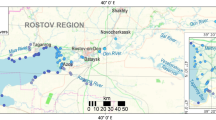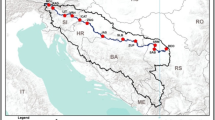Abstract
Extreme flooding in May, 2014 affected the sub-catchments of six major rivers in Serbia. The goal of the study was to evaluate the contents of potentially toxic elements (PTEs) As, Cd, Pb, Cr, Ni, Cu, and Zn in flood sediments and arable soils within the affected sub-catchments using regulatory guidelines and background levels. The sub-catchment of West Morava was selected to assess the degree of sediments and soils contamination and environmental risk [using the Pollution index (Pi), Enrichment factor, Geo-accumulation index, and Potential ecological risk index (PERI)] as well as to identify main PTEs sources by Principal component (PCA) and cluster analysis. Contents of Ni, Cr, As, Pb, and Cu above both guidelines and background levels, and of Zn and Cd above background levels were detected in the sediments and soils from all the sub-catchments. Pi indicted that about 95% of the soils and sediments were extremely polluted by Ni and about 65% slightly polluted by Cr, whereas about 90% were not polluted by As, Cd, Pb, Cu, or Zn. Ef indicated minor to moderate enrichment of the soils and sediments by Ni, and Cr. PCA differentiated a geogenic origin of Ni, Cr, As, and Pb, a mixed origin of Cd and Zn, and a predominantly anthropogenic origin of Cu. PERI of the soils and sediments suggested a low overall multi-element ecological risk. The ecological risk of the individual elements (E ir ) for soils was Zn < Cr < Pb < Ni < Cu < As < Cd.




Similar content being viewed by others
References
Alexander, L. V., Zhang, X., Peterson, T. C., et al. (2006). Global observed changes in daily climate extremes of temperature and precipitation. Journal of Geophysical Research, 111, D05109. https://doi.org/10.1029/2005JD006290.
Amacher, M. C. (1996). Nickel, Cadmium, and Lead. In D. L. Spark (Ed.), Methods of soil analysis, part 3, chemical methods (pp. 49–65). Madison: Soil Science Society of America and American Society of Agronomy.
Antić-Mladenović, S., Frohne, T., Kresović, M., Stärk, H.-J., Tomić, Z., Ličina, V., et al. (2017). Biogeochemistry of Ni and Pb in a periodically flooded arable soil: Fractionation and redox-induced (im)mobilization. Journal of Environmental Management, 186(2), 141–150.
Antić-Mladenović, S., Rinklebe, J., Frohne, T., Stärk, H.-J., Wennrich, R., Tomić, Z., et al. (2011). Impact of controlled redox conditions on nickel in a serpentine soil. Journal of Soils and Sediments, 11, 406–415.
Antoniadis, V., Levizou, E., Shaheen, S. M., Ok, Y. S., Sebastian, A., Baum, C., et al. (2017). Trace elements in the soil-plant interface: Phytoavailability, translocation, and phytoremediation–a review. Earth-Science Reviews, 171, 621–645.
Bani, A., Echevarria, G., Montarges-Pelletier, E., Gjoka, F., Sulce, S., & Morel, J. L. (2014). Pedogenesis and nickel biogeochemistry in a typical Albanian ultramafic toposequence. Environmental Monitoring and Assessment, 186(7), 4431–4442.
Berner, Z. A., Bleeck-Schmidt, S., Stüben, D., Neumann, T., Fuchs, M., & Lehmann, M. (2012). Floodplain deposits: A geochemical archive of flood history—A case study on the River Rhine Germany. Applied Geochemistry, 27(3), 543–561.
Čakmak, D., Perović, V., Antić-Mladenović, S., Kresović, M., Saljnikov, E., Mitrović, M., et al. (2017). Contamination, risk, and source apportionment of potentially toxic microelements in river sediments and soil after extreme flooding in the Kolubara River catchment in Western Serbia. Journal of Soils and Sediments. https://doi.org/10.1007/s11368-017-1904-0.
Cao, Y., Zhang, D., Shen, F., Wang, J., Falandysz, J., Jarzyńska, G., et al. (2013). As, Cd, Cr, Hg, Ni and Pb in Soil from Eastern Slope of Mt. Gongga, Eastern Tibet, China. Advance Journal of Food Science and Technology, 5(6), 775–782.
Cerny, C. A., & Kaiser, H. F. (1977). A study of a measure of sampling adequacy for factor-analytic correlation matrices. Multivariate Behavioral Research, 12(1), 43–47.
Ciszewski, D., & Matys Grygar, T. (2016). A review of flood-related storage and remobilization of heavy metal pollutants in river systems. Water, Air, and Soil pollution, 227, 239. https://doi.org/10.1007/s11270-016-2934-8.
Dill, H. G., Sachsenhofer, R. F., Grecula, P., Sasvári, T., Palinkaš, L. A., Borojević-Šoštarić, S., et al. (2008). Fossil fuels, ore and industrial minerals. In T. McCann (Ed.), The geology of Central Europe (Vol. 2, pp. 1341–1449)., Mesozoic and Cenozoic London: The Geological Society Publishing House.
Dimitrijević, D. M. (1992). Geological map of Serbia 1:2.000.000. In R.F.f.G. Research (Ed.), Belgrade: Geological atlas of Serbia.
Du Laing, G., Rinklebe, J., Vandecasteele, B., Meers, E., & Tack, F. M. G. (2009). Trace metal behaviour in estuarine and riverine floodplain soils and sediments: A review. Science of the Total Environment, 407(13), 3972–3985.
Farooq, M. A., Islam, F., Ali, B., Najeeb, U., Mao, B., Gill, R. A., et al. (2016). Arsenic toxicity in plants: Cellular and molecular mechanisms of its transport and metabolism. Environmental and Experimental Botany, 132, 42–52.
Foulds, S. A., Brewer, P. A., Macklin, M. G., Haresign, W., Betson, R. E., & Rassner, S. M. E. (2014). Flood-related contamination in catchments affected by historical metal mining: An unexpected and emerging hazard of climate change. Science of the Total Environment, 476–477, 165–180.
Fowler, J., Cohen, L., & Jarvis, P. (2006). Practical statistics for field biology. Chichester: Wiley.
Frohne, T., Rinklebe, J., & Diaz-Bone, R. A. (2014). Contamination of floodplain soils along the Wupper River, Germany, with As Co, Cu, Ni, Sb, and Zn and the impact of pre-definite redox variations on the mobility of these elements. Soil and Sediment Contamination, 23(7), 779–799.
Green, C., Dieperink, C., Ek, K., Hegger, D. L. T., Pettersson, M., Priest, S., Tapsell, S. (2013). Flood risk management in Europe: The flood problem and interventions (report no D1.1.1, ISBN: 978-94-91933-02-8). Utrecht: STAR-FLOOD Consortium.
Guo, Y., Huang, C. C., Pang, J., Zha, X., Li, X., & Zhang, Y. (2014). Concentration of heavy metals in the modern flood slackwater deposits along the upper Hanjiang River valley, China. CATENA, 116, 123–131.
Hakanson, L. (1980). An ecological risk index for aquatic pollution control. A sedimentological approach. Water Research, 14, 975–1001.
Hereter, A., Josa, R., & Candela, X. (2002). Changes in particle-size distribution influenced by organic matter and mechanical or ultrasonic dispersion techniques. Communications in Soil Science and Plant Analysis, 33, 1351–1362.
Jiménez-Ballesta, R., García-Navarro, F. J., Bravo, S., Amorós, J. A., Pérez-de-los-Reyes, C., & Mejías, M. (2016). Environmental assessment of potential toxic trace element contents in the inundated floodplain area of tablas de Daimiel wetland (Spain). Environmental Geochemistry and Health. https://doi.org/10.1007/s10653-016-9884-3.
Kaiser, H. (1974). An index of factor simplicity. Psychometrika, 39, 31–36.
Lekić, D., & Jovanović, M. (2015). The report on the environmental conditions in the Republic of Serbia for 2014 (In Serbian). Belgrade: Ministry of agriculture and environmental protection-agency for the environmental protection.
Ličina, V., Antić-Mladenović, S., Kresović, M., & Rinklebe, J. (2010). Effect of high Ni and Cr background levels in serpentine soil on their accumulation in organs of perennial plant (Vitis vinifera L.). Communications in Soil Science and Plant Analysis, 41(4), 482–496.
Liu, J., Wang, J., Chen, Y., **e, X., Qi, J., Lippold, H., et al. (2016). Thallium transformation and partitioning during Pb–Zn smelting and environmental implications. Environmental Pollution, 212, 77–89.
Lombi, E., Sletten, R. S., & Wenzel, W. W. (2000). Sequentially extracted arsenic from different size fractions of contaminated soils. Water, Air, and Soil pollution, 124, 319–332.
Majerová, L., Matys Grygar, T., Elznicová, J., & Strnad, L. (2013). The differentiation between point and diffuse industrial pollution of the floodplain of the Ploučnice River, Czech Republic. Water, Air, and Soil pollution, 224, 1688. https://doi.org/10.1007/s11270-013-1688-9.
Martínez-Santos, M., Probst, A., García-García, J., & Ruiz-Romera, E. (2015). Influence of anthropogenic inputs and a high-magnitude flood event on metal contamination pattern in surface bottom sediments from the Deba River urban catchment. Science of the Total Environment, 514, 10–25.
Matys Grygar, T., Nováková, T., Bábek, O., Elznicová, J., & Vadinová, N. (2013). Robust assessment of moderate heavy metal contamination levels in floodplain sediments: A case study on the Jizera River, Czech Republic. Science of the Total Environment, 452–453, 233–245.
Matys Grygar, T., & Popelka, J. (2016). Revisiting geochemical methods of distinguishing natural concentrations and pollution by risk elements in fluvial sediments. Journal of Geochemical Exploration, 170, 39–57.
Mrvić, V., Antonović, G., & Martinović, Lj. (2009). Fertility and content of hazardous and harmful substances in the soils of central Serbia. Monograph. Belgrade: Institute for Soil Science. (in Serbian).
Mrvić, V., Kostić-Kravljanac, Lj, Čakmak, D., Sikirić, B., Brebanović, B., Perović, V., et al. (2011). Pedogeochemical map** and background limit of trace elements in soils of Branicevo Province (Serbia). Journal of Geochemical Exploration, 109(1–3), 18–25.
Predić, T., Nikić Nauth, P., Radanović, B., & Predić, A. (2016). State of heavy metals pollution of flooded agricultural land in the north part of Republic of Srpska. Agroznanje-Agro-knowledge Journal, 17(1), 19–27.
Rajapaksha, A. U., Vithanage, M., Oze, C., Bandara, W. M. A. T., & Weerasooriya, R. (2012). Nickel and manganese release in serpentine soil from the Ussangoda Ultramafic Complex, Sri Lanka. Geoderma, 189–190, 1–9.
Raous, S., Becquer, T., Garnier, J., Martins, Éd S, Echevarria, G., & Sterckeman, T. (2010). Mobility of metals in nickel mine spoil materials. Applied Geochemistry, 25(11), 1746–1755.
Raous, S., Echevarria, G., Sterckeman, T., Hanna, K., Thomas, F., Martins, E. S., et al. (2013). Potentially toxic metals in ultramafic mining materials: Identification of the main bearing and reactive phases. Geoderma, 192, 111–119.
Reimann, C., Filzmoser, P., & Garrett, R. G. (2005). Background and threshold: Critical comparison of methods of determination. Science of the Total Environment, 346(1–3), 1–16.
Rinklebe, J., Antić-Mladenović, S., Frohne, T., Stärk, H.-J., Tomić, Z., & Ličina, V. (2016). Nickel in a serpentine-enriched Fluvisol: Redox affected dynamics and binding forms. Geoderma, 263, 203–214.
Rinklebe, J., Franke, C., & Neue, H.-U. (2007). Aggregation of floodplain soils as an instrument for predicting concentrations of nutrients and pollutants. Geoderma, 141(3–4), 210–223.
Rinklebe, J., & Shaheen, S. M. (2014). Assessing the mobilization of cadmium, lead, and nickel using a seven-step sequential extraction technique in contaminated floodplain soil profiles along the central Elbe River, Germany. Water, Air, and Soil pollution, 225, 2039. https://doi.org/10.1007/s11270-014-2039-1.
Rinklebe, J., & Shaheen, S. M. (2017). Geochemical distribution of Co, Cu, Ni, and Zn in soil profiles of Fluvisols, Luvisols, Gleysols, and Calcisols originating from Germany and Egypt. Geoderma, 307, 122–138.
Rodgers, K. A. (1972). The decomposition and analysis of chrome spinel. A survey of some published techniques. Mineralogical Magazine, 38, 882–889.
Shaheen, S. M., Kwon, E. E., Biswas, J. K., Tack, F. M. G., Ok, Y. S., & Rinklebe, J. (2017). Arsenic, chromium, molybdenum, and selenium: geochemical fractions and potential mobilization in riverine soil profiles originating from Germany and Egypt. Chemosphere, 180, 553–563.
Snedecor, G. W., & Cochran, W. G. (1989). Statistical methods (8th ed.). Ames: Iowa State University Press.
Todorovic, Z., & Breton, N. P. (2014). A geographic information system screening tool to tackle diffuse pollution through the use of sustainable drainage systems. Water Science and Technology, 69(10), 2066–2073.
Trenberth, K. E. (2011). Changes in precipitation with climate change. Climate Research, 47(1–2), 123–138.
US EPA. (1996). Method 3050B. Acid digestion of sediments, sludges, and soils revision 2.
Westra, S., Alexander, L. V., & Zwiers, F. W. (2013). Global increasing trends in annual maximum daily precipitation. Journal of Climate, 26, 3904–3918.
Westra, S., Fowler, H. J., Evans, J. P., Alexander, L. V., Berg, P., Johnson, F., et al. (2014). Future changes to the intensity and frequency of short duration extreme rainfall. Reviews of Geophysics, 52, 522–555.
Westrich, B., & Förstner, U. (2007). Sediment dynamics and pollutant mobility in rivers. An interdisciplinary approach. Berlin: Springer.
Zhao, Y., & Marriott, S. B. (2013). Dispersion and remobilisation of heavy metals in the River Severn system, UK. Procedia Environmental Sciences, 18, 167–173.
Acknowledgements
This study was supported by the Serbian Ministry of Science and Technological Development (Projects III 43007, 37006, and 173018).
Author information
Authors and Affiliations
Corresponding author
Electronic supplementary material
Below is the link to the electronic supplementary material.
Rights and permissions
About this article
Cite this article
Antić-Mladenović, S., Kresović, M., Čakmak, D. et al. Impact of a severe flood on large-scale contamination of arable soils by potentially toxic elements (Serbia). Environ Geochem Health 41, 249–266 (2019). https://doi.org/10.1007/s10653-018-0138-4
Received:
Accepted:
Published:
Issue Date:
DOI: https://doi.org/10.1007/s10653-018-0138-4




